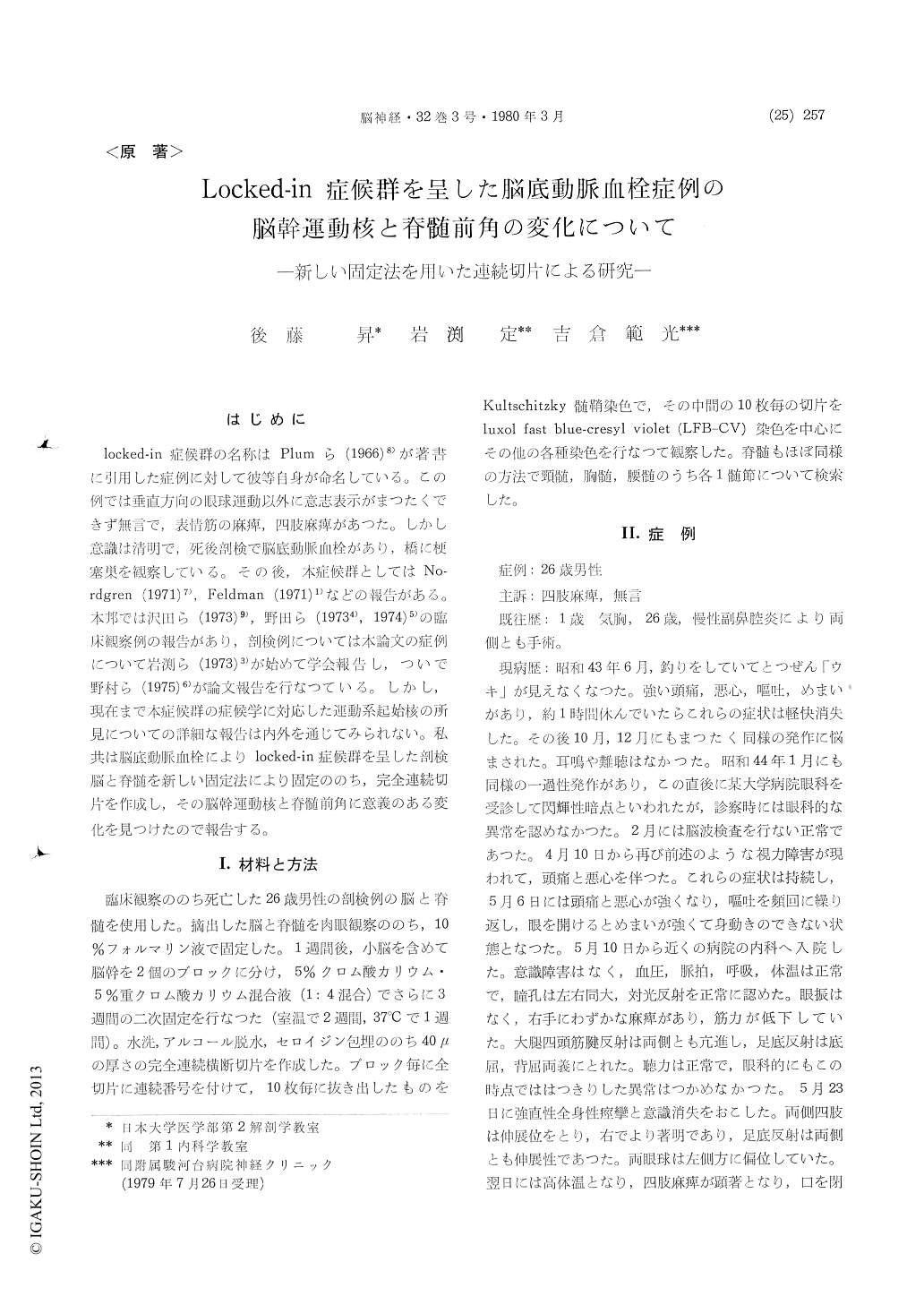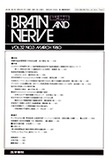Japanese
English
- 有料閲覧
- Abstract 文献概要
- 1ページ目 Look Inside
はじめに
locked-in症候群の名称はPlumら(1966)8)が著書に引用した症例に対して彼等自身が命名している。この例では垂直方向の眼球運動以外に意志表示がまつたくできず無言で,表情筋の麻痺,四肢麻痺があつた。しかし意識は清明で,死後剖検で脳底動脈血栓があり,橋に梗塞巣を観察している。その後,本症候群としてはNo—rdgren (1971)7),Feldman (1971)1)などの報告がある。本邦では沢田ら(1973)9),野田ら(19734),(1974)5)の臨床観察例の報告があり,剖検例については本論文の症例について岩渕ら(1973)3)が始めて学会報告し,ついで野村ら(1975)6)が論文報告を行なつている。しかし,現在まで本症候群の症候学に対応した運動系起始核の所見についての詳細な報告は内外を通じてみられない。私共は脳底動脈血栓によりlocked-in症候群を呈した剖検脳と脊髄を新しい固定法により固定ののち,完全連続切片を作成し,その脳幹運動核と脊髄前角に意義のある変化を見つけたので報告する。
In this study, a postmortem case of a 26-year-old man suffering from basilar artery thrombosis and pontine basis infarction with clinical locked-in state and trismus was used.
The patient had a sudden onset of transient blindness while fishing. There followed severe headache, nausea, vertigo and vomiting, which subsided an hour later. Then, he had similar occurences four times over the following ten months. This condition was finally diagnosed as scintilating scotoma when he consulted an ophthalmologist. About twelve months after the onset, he suffered a generalized tonic convulsion with loss of consciousness. After that, he showed quadriplegia with a posture of extended extremities which was more noticeable on the right, bilateral deep tendon hyperreflexia with extensor plantars,bilateral facial palsy, disturbance of the tongue movements, dysarthria, mutism, trismus followed by paralysis of the jaw one month later, and loss of horizontal gaze with intact vertical movements which, being alert, he utilized as a means of communication. No horizontal ocular movements were observed when his head was passively turned to both sides. He had normal corneal reflexes and no ocular bobbing. His ocular fundi and visual acuity were normal. He didn't have any defect of vision. His eyes kept half open. But, he could close his eyes by synkinetic movements of the upper eyelids (blinking or downward gaze). No horizontal optokinetic nystagmus could be elicited to either side. He showed no gag reflex. He was able to swallow food automatically in spite of the absence of any voluntary movements of swallowing. Sensations such as light touch, pin prick, thermal stimuli and vibration were normal all over the body. No fasciculations or atrophies of the chewing and facial muscles could be observed. Blood ex-aminations and CSF were all normal during the hospitalization. He died after sudden arrest of respiration fourteen months after the onset.
Postmortem examination disclosed that the brain weighed 1,400 g, that the basilar artery occluded at the lower two thirds from the joining point of the bilateral vertebral arteries, and that the left posterior inferior cerebellar and right superior cerebellar arteries were stenotic with scattered atheromatous plaques. The occluded basilar artery was well organised histologically without recanal-ization. A linear softening area was found continuing from the upper surface to part of the posterior inferior surface of the left cerebellar hemisphere.
On sections of the cerebrum (telencephalon, diencephalon and mesencephalon), no macroscopical changes were found. A softening lesion measuring 1.5 × 1.0 × 2.0 cm was observed in the pontine basis with a cavity in the center (Fig. 1). This lesion destroyed most of the bilateral longitudinal tracts which were composed of corticospinal, cortico-nuclear and corticopontine tracts. The linear infarction mentioned above reached to the corpus medullaris of the left cerebellar hemisphere, but spared the dentate nucleus on that side.
The brain stem, the cerebellum and the spinal cord were examined after making serial sections embedded in celloidine after secondary fixation with 5% mixed solution of potassium chromate and potassium dichromate for three weeks.
Secondary degeneration in the pyramidal tracts was bilaterally observed in the medulla oblongata and the spinal cord. Motor nuclei of the cranial nerves and anterior horns of the spinal cord wereprecisely investigated with serial sections. Oculo-motor and trochlear nuclei which are located above the primary lesion, were completely normal on both sides (Fig. 2 and 3). But, the other motor nuclei showed expected changes (the so-called chronic degeneration of Nissl). Each motor nucleus showed findings very similar to the opposite. Nerve cells in those nuclei didn't decrease or increase in number. No glial reaction was noticed. In the motor trigeminal nuclei (Fig. 4), most of nerve cells were atrophic or sclerotic bilaterally, and their cell bodies were concaved to the outside. They were so darkly stained that their nuclei, nucleoli and Nissl bodies could not be clearly dis-tinguished. Long processus were stained (up to four times the length of the average between the longest and the shortest cell diameters). Several neurones had corkscrew-like processus. In the abducent nuclei (Fig. 5), nerve cells composed of relatively small atrophic neurons, among which some showed findings of central chromatolysis, were observed. Their processus were stained as long as the average lengths between the longest and the shortest diameters of the cell bodies. The facial nuclei showed changes similar to those of the motor trigeminal nuclei (Fig. 6). But, the processus were stained up to twice the lengths of the average diameters. In the ambiguus nuclei (Fig. 7), nerve cells showed only slight findings of atrophy on both sides. There could be observed many neurons which looked almost normal in spite of a tendency to have concaved cell bodies, biased cell nuclei, long stained processus, etc. Nerve cells in the hypoglossal nuclei (Fig. 8) were composed of neurons which were remarkablly sclerotic or atrophic and had much thicker processus (although they were about the same length, i. e. up to five times the average diameters) than those of the motor tri-geminal neurons. Most of the anterior horn neurons at the levels of C3 (Fig. 9) and Th4 (Fig. 10) were sclerotic on both sides, so that Nissl bodies, cell nuclei and nucleoli were not identified. Their findings were similar to those of the motor trigeminal and the facial nuclei. In the lumbar anterior horns (L2), however, both sides revealed different findings. Although the right side showed changes similar to the cervical and thoracic cords, the left anterior horn showed different stages of changes such as central chromatolysis, sclerosis, and even normal nerve cells (Fig. 11).
Then, this paper discusses on the points of vascular supply into the pontine lesion, of the new fixation method used in this study and of findings in the motor cranial nuclei and anterior horns of the spinal cord.
Finally, we concluded as follows :
1) A clinical observation was made on a case of pontine basis infarction with locked-in syndrome. The brain stem and the cerebellum were precisely examined by making serial sections after a new fixation.
2) Changes due to transsynaptic influences of degenerated bilateral pyramidal tracts (the so-called chronic degeneration of Nissl), were observed on both sides in the motor cranial nuclei and the spinal anterior horns with normal findings in theoculomotor and the trochlear nuclei in the midbrain. These findings were thought to correspond to the clinical signs and symptoms of the locked-in syndrome.
3) The new secondary fixation method described herein is extremely useful and is particularly well adapted to the correlation between neuronal changes and neurological symptomatology.

Copyright © 1980, Igaku-Shoin Ltd. All rights reserved.


